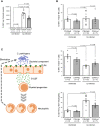Toll-Like Receptor 4 Protects Against Clostridium perfringens Infection in Mice
- PMID: 33763386
- PMCID: PMC7982660
- DOI: 10.3389/fcimb.2021.633440
Toll-Like Receptor 4 Protects Against Clostridium perfringens Infection in Mice
Abstract
Toll-like receptor 4 (TLR4) has been reported to protect against Gram-negative bacteria by acting as a pathogen recognition receptor that senses mainly lipopolysaccharide (LPS) from Gram-negative bacteria. However, the role of TLR4 in Gram-positive bacterial infection is less well understood. Clostridium perfringens type A is a Gram-positive bacterium that causes gas gangrene characterized by severe myonecrosis. It was previously demonstrated that C. perfringens θ-toxin is a TLR4 agonist, but the role of TLR4 in C. perfringens infection is unclear. Here, TLR4-defective C3H/HeJ mice infected with C. perfringens showed a remarkable decrease in survival rate, an increase in viable bacterial counts, and accelerated destruction of myofibrils at the infection site compared with wild-type C3H/HeN mice. These results demonstrate that TLR4 plays an important role in the elimination of C. perfringens. Remarkable increases in levels of inflammatory cytokines, such as interleukin-1β (IL-1β), interleukin-6 (IL-6), and granulocyte colony-stimulating factor (G-CSF), were observed in C. perfringens-infected C3H/HeN mice, whereas the increases were limited in C3H/HeJ mice. Generally, increased G-CSF accelerates granulopoiesis in the bone marrow and the spleen to exacerbate neutrophil production, resulting in elimination of bacteria. The number of neutrophils in the spleen was increased in C. perfringens-infected C3H/HeN mice compared with non-infected mice, while the increase was lower in C. perfringens-infected C3H/HeJ mice. Furthermore, DNA microarray analysis revealed that the mutation in TLR4 partially affects host gene expression during C. perfringens infection. Together, our results illustrate that TLR4 is crucial for the innate ability to eliminate C. perfringens.
Keywords: Clostridium (C.) perfringens; G-CSF; Granulopoiesis; TLR4; innate immunity.
Copyright © 2021 Takehara, Kobayashi and Nagahama.
Conflict of interest statement
The authors declare that the research was conducted in the absence of any commercial or financial relationships that could be construed as a potential conflict of interest.
Figures




Similar articles
-
[Host Defense against Bacterial Infection and Bacterial Toxin-induced Impairment of Innate Immunity].Yakugaku Zasshi. 2018;138(10):1249-1253. doi: 10.1248/yakushi.18-00102. Yakugaku Zasshi. 2018. PMID: 30270267 Review. Japanese.
-
Clostridium perfringens α-toxin impairs granulocyte colony-stimulating factor receptor-mediated granulocyte production while triggering septic shock.Commun Biol. 2019 Jan 31;2:45. doi: 10.1038/s42003-019-0280-2. eCollection 2019. Commun Biol. 2019. PMID: 30729183 Free PMC article.
-
Effect of Clostridium perfringens type C on TLR4/MyD88/NF-κB signaling pathway in piglet small intestines.Microb Pathog. 2019 Oct;135:103567. doi: 10.1016/j.micpath.2019.103567. Epub 2019 Jun 1. Microb Pathog. 2019. PMID: 31163250
-
Toll-like receptor 4-deficient mice have reduced bone destruction following mixed anaerobic infection.Infect Immun. 2000 Aug;68(8):4681-7. doi: 10.1128/IAI.68.8.4681-4687.2000. Infect Immun. 2000. PMID: 10899873 Free PMC article.
-
Toll-like receptor 4 expression is required to control chronic Mycobacterium tuberculosis infection in mice.J Immunol. 2002 Sep 15;169(6):3155-62. doi: 10.4049/jimmunol.169.6.3155. J Immunol. 2002. PMID: 12218133
Cited by
-
STING-dependent trained immunity contributes to host defense against Clostridium perfringens infection via mTOR signaling.Vet Res. 2024 Apr 15;55(1):52. doi: 10.1186/s13567-024-01301-1. Vet Res. 2024. PMID: 38622656 Free PMC article.
-
Pan-Genome Analysis of Oral Bacterial Pathogens to Predict a Potential Novel Multi-Epitopes Vaccine Candidate.Int J Environ Res Public Health. 2022 Jul 9;19(14):8408. doi: 10.3390/ijerph19148408. Int J Environ Res Public Health. 2022. PMID: 35886259 Free PMC article.
-
Toxigenic Profile of Clostridium perfringens Strains Isolated from Natural Ingredient Laboratory Animal Diets.Comp Med. 2022 Feb 1;72(1):50-58. doi: 10.30802/AALAS-CM-22-000013. Epub 2022 Feb 11. Comp Med. 2022. PMID: 35148812 Free PMC article.
-
Immunoinformatic analysis of the whole proteome for vaccine design: An application to Clostridium perfringens.Front Immunol. 2022 Aug 30;13:942907. doi: 10.3389/fimmu.2022.942907. eCollection 2022. Front Immunol. 2022. PMID: 36110855 Free PMC article.
-
An autopsy case of gas gangrene, massive intravascular hemolysis, and cytokine storm due to Clostridium perfringens type A infection.IDCases. 2024 Oct 3;38:e02085. doi: 10.1016/j.idcr.2024.e02085. eCollection 2024. IDCases. 2024. PMID: 39435138 Free PMC article.
References
-
- Bahl H., Dürre P. (2001). Clostridia : biotechnology and medical applications., (Weinheim Chichester: Wiley-VCH; ).
Publication types
MeSH terms
Substances
LinkOut - more resources
Full Text Sources
Other Literature Sources

